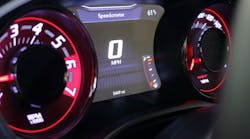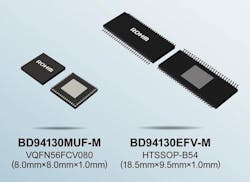This article is part of the TechXchange: Advanced Display Technology.
The problem isn’t a new one. In recent years, expanding car infotainment functionality has prompted a shift toward higher-resolution vehicle displays. With many cars boasting six or more displays (when you include the smart back mirror, head-up display or HUD, rear seat mount on the head support, and rear seat mount on the roof) and the fact that displays are usually tougher to extract satisfactory performance from than many automotive systems, designers have a full plate of difficulties.
Constant current and constant voltage drivers are both viable options for a power supply for LED light sources. However, to meet illumination requirements, for example, LEDs require a constant current to produce consistent lighting—current fluctuations can occur—and voltage-supply variations in vehicles must be avoided.
What’s more, exterior lighting has applications where bright and normal output must be obtained from the same LEDs. Brake lights/taillights, low-beam/daytime-running lights, and high-beam/low-beam headlights are examples of bi-level lighting. In some cases, lighting design may be able to address both situations using the same LEDs with the right LED driver.
Each item would pose significant challenges on its own. But the automotive display must do them all nearly simultaneously, adding layers of complexity to the tasks at hand.
The Need for Advanced LED Drivers
Delivering this performance requires LED drivers featuring multichannel operation and advanced dimming features that can prevent unwanted flicker effects. LED drivers with a local dimming function have been developed that only turn off the backlight in dark areas of the LCD do improve display screen performance and reduce power consumption.
However, as the number of zones controlled with conventional direct-type LED drivers by a single IC is less than 100, the number of LED drivers and peripheral components increases as automotive displays become larger with more zones. This represents a significant design challenge.
ROHM’s Matrix LED Drivers
The future LED driver will be required to control more zones than conventional ICs, making it possible to reduce the mounting area by using less LED drivers. ROHM’s new BD94130xxx-M series of matrix LED drivers combines an 8-line switch controller with 24-channel current driver, allowing for control (dimming) of up to 192 zones of mini-LEDs for backlighting with a single IC. Furthermore, the mini-LEDs in each zone can be independently adjusted by using a local dimming function, contributing to larger-contrast-ratio, lower-power displays.
The new matrix LED driver ICs—BD94130MUF-ME2 and BD94130EFV-ME2—target automotive LCD backlights and large displays like next-generation car infotainment and instrument clusters. They combine the 24-channel current driver with a switch controller that can be divided into eight lines (max). The number of switch controller lines can be selected from among three patterns (4, 6, or 8) via register settings, supporting a variety of specifications based on the number of zones and LED current consumption.
In addition, a built-in feedback control function maintains a constant feedback voltage independent of LED temperature characteristics, reducing thermal-design man-hours along with loss ratio.
ROHM explains that the new devices enable operation with just one-fourth of the number of LED drivers compared to existing (48-zone) products, decreasing LED driver mounting area by approximately 84%. And this advantage will only increase as screens become larger and the number of zones rises inside next-generation cockpits.
Read more articles in the TechXchange: Advanced Display Technology.

